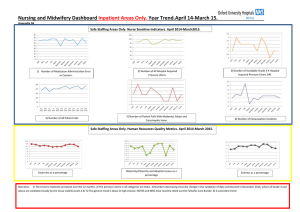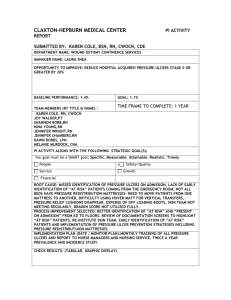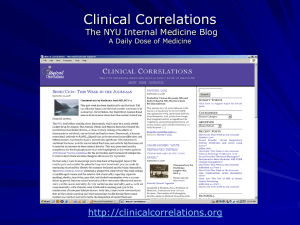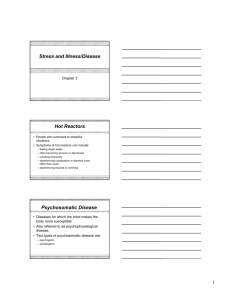Document 13214377
advertisement
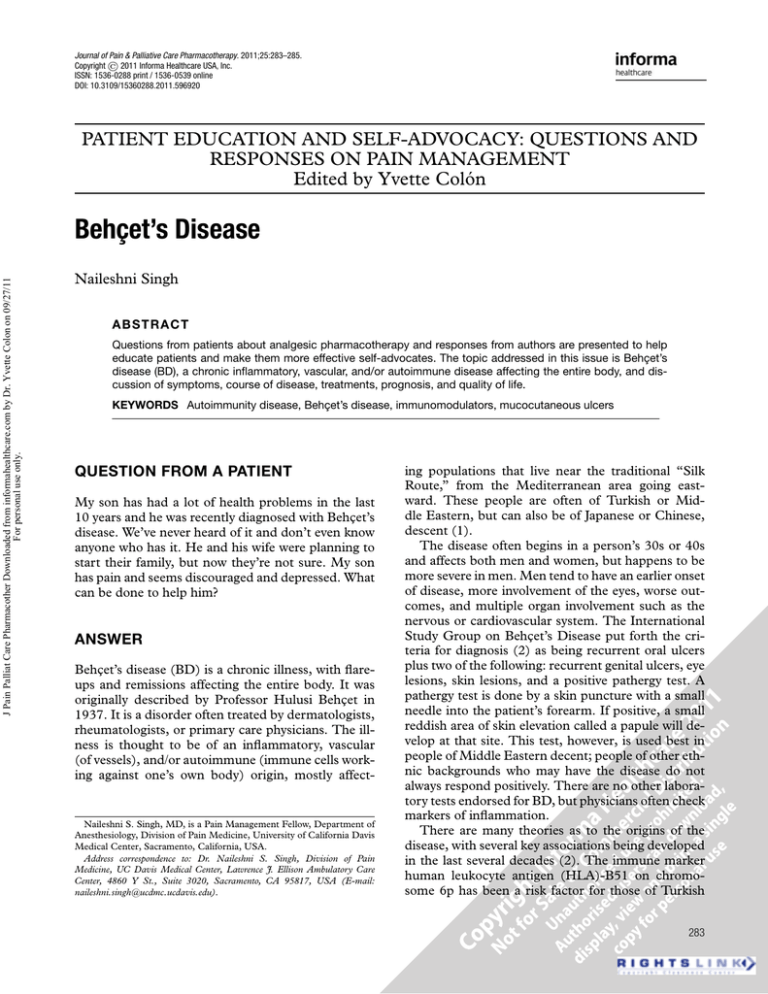
Journal of Pain & Palliative Care Pharmacotherapy. 2011;25:283–285. Copyright © 2011 Informa Healthcare USA, Inc. ISSN: 1536-0288 print / 1536-0539 online DOI: 10.3109/15360288.2011.596920 PATIENT EDUCATION AND SELF-ADVOCACY: QUESTIONS AND RESPONSES ON PAIN MANAGEMENT Edited by Yvette Colón J Pain Palliat Care Pharmacother Downloaded from informahealthcare.com by Dr. Yvette Colon on 09/27/11 For personal use only. Behçet’s Disease Naileshni Singh A B STRA CT Questions from patients about analgesic pharmacotherapy and responses from authors are presented to help educate patients and make them more effective self-advocates. The topic addressed in this issue is Behçet’s disease (BD), a chronic inflammatory, vascular, and/or autoimmune disease affecting the entire body, and discussion of symptoms, course of disease, treatments, prognosis, and quality of life. KEYWORDS Autoimmunity disease, Behçet’s disease, immunomodulators, mucocutaneous ulcers QUESTION FROM A PATIENT My son has had a lot of health problems in the last 10 years and he was recently diagnosed with Behçet’s disease. We’ve never heard of it and don’t even know anyone who has it. He and his wife were planning to start their family, but now they’re not sure. My son has pain and seems discouraged and depressed. What can be done to help him? ANSWER Behçet’s disease (BD) is a chronic illness, with flareups and remissions affecting the entire body. It was originally described by Professor Hulusi Behçet in 1937. It is a disorder often treated by dermatologists, rheumatologists, or primary care physicians. The illness is thought to be of an inflammatory, vascular (of vessels), and/or autoimmune (immune cells working against one’s own body) origin, mostly affect- Naileshni S. Singh, MD, is a Pain Management Fellow, Department of Anesthesiology, Division of Pain Medicine, University of California Davis Medical Center, Sacramento, California, USA. Address correspondence to: Dr. Naileshni S. Singh, Division of Pain Medicine, UC Davis Medical Center, Lawrence J. Ellison Ambulatory Care Center, 4860 Y St., Suite 3020, Sacramento, CA 95817, USA (E-mail: naileshni.singh@ucdmc.ucdavis.edu). ing populations that live near the traditional “Silk Route,” from the Mediterranean area going eastward. These people are often of Turkish or Middle Eastern, but can also be of Japanese or Chinese, descent (1). The disease often begins in a person’s 30s or 40s and affects both men and women, but happens to be more severe in men. Men tend to have an earlier onset of disease, more involvement of the eyes, worse outcomes, and multiple organ involvement such as the nervous or cardiovascular system. The International Study Group on Behçet’s Disease put forth the criteria for diagnosis (2) as being recurrent oral ulcers plus two of the following: recurrent genital ulcers, eye lesions, skin lesions, and a positive pathergy test. A pathergy test is done by a skin puncture with a small needle into the patient’s forearm. If positive, a small reddish area of skin elevation called a papule will develop at that site. This test, however, is used best in people of Middle Eastern decent; people of other ethnic backgrounds who may have the disease do not always respond positively. There are no other laboratory tests endorsed for BD, but physicians often check markers of inflammation. There are many theories as to the origins of the disease, with several key associations being developed in the last several decades (2). The immune marker human leukocyte antigen (HLA)-B51 on chromosome 6p has been a risk factor for those of Turkish 283 J Pain Palliat Care Pharmacother Downloaded from informahealthcare.com by Dr. Yvette Colon on 09/27/11 For personal use only. 284 Y. Colón and N. Singh and Japanese origins. But the disease is thought to be caused by multiple genes so inheritance patterns are not clear. Environmental factors such as bacteria and viruses have also been analyzed. The herpes simplex virus and the bacteria Streptococcus sanguis may be linked to the disease where the immune system mounts an attack against those organisms, but ends up destroying the body’s own tissues instead. Also, many different cells in the immune system may be interacting abnormally to cause the spectrum of disease seen in Behçet’s (2). The hallmark of BD is oral ulcers, which is usually the first sign of disease. Ulcers are deep erosions of the skin that are often painful. Similar ulcers occur in the genital area and in the gastrointestinal tract. Oral, skin, and genital manifestations are collectively known as mucocutaneous lesions. Ulcers in the gastrointestinal system can cause vomiting, diarrhea, poor appetite, and pain. Skin lesions are often raised, but rarely cause ulcers. In addition, patients may have arthritic changes of their knees, ankles, and wrists, which can cause a significant amount of disability. Multiple other organ systems are afflicted by BD. Eye involvement can cause blindness in up to 25% of people with BD. This usually happens several years after the onset of symptoms and involves inflammation of the critical structures of the eye. Neurological, vascular, and cardiac manifestations may also occur. This can lead to paralysis, changes in behavior, incontinence, headaches, blood clots, and aneurysms throughout the body. The muscle, valves, and vessels of the heart also can be affected rarely. Patients should be assessed for involvement of critical organs as their disease progresses. The pain related to Behçet’s disease may be alleviated by treating symptoms, namely with immune modulators. Immune modulators are medicines often used in cancers or other diseases of an inflammatory nature such as rheumatoid arthritis. They serve to alter the immune system or the body’s immune response in multiple different ways. Corticosteroids are one such class of medications used in a variety of forms such as topical, oral, or intravenous, or as eye drops. Some patients get treated with high-dose steroids for several weeks to aid in eye, skin, neurological, gastrointestinal, and cardiovascular diseases. But steroids are usually combined with other agents to enhance the effectiveness of the overall treatment. Studies have shown a decrease in pain and improvements in healing with steroids (3). Drugs that act upon the immune system have been shown to work quickly and effectively in multiple aspects of BD. For example, interferon-α is helpful in oral and genital ulcers and ocular, neurological, skin, and vascular diseases. Studies have shown that patients have better vision and even remission of the process that causes the eye damage. Tumor necrosis factor-α also can be helpful in eye disease. It is used in the mucocutaneous and arthritic signs of the disease that may not respond to other treatments. A common antigout medication, colchicine, is best used for skin and joint diseases. It is, in fact, the first-choice drug for many symptoms of BD. Azathioprine has also been shown to reduce the symptoms involving the eye, joints, gastrointestinal system, and oral lesions. In addition, it may improve the long-term prognosis of BD and can be used as a preventive medication for eye disease. Oral ulcer pain can often be decreased by antibiotic mouthwash and proper oral hygiene. Antibiotics such as tetracycline, minocycline, penicillin G, and cephalexin have long been used to reduce pain, promote ulcer healing, and prevent infection of the ulcers. Other agents, such as sucralfate and sulfasalazine, are useful in coating the ulcers to support healing (3). Traditional anticancer drugs, such as cyclophosphamide, methotrexate, and cyclosporin A, have shown to be helpful in eye, vascular, and nervous system diseases that don’t respond to steroids. In other instances, these drugs are combined with steroids to reduce the total steroid dose that patients receive and to provide for a multilevel approach to treatment. Pain medications such as nonsteroidal antiinflammatory drugs (NSAIDs) (e.g., ibuprofen) and opioids (e.g., vicodin) have been shown to decrease the pain in multiple case report studies. The NSAIDs are often used for the joint type pain, whereas opioids can be used for a variety of painful syndromes. The choice of pain medication to be used should be based on the location of the pain, possible mechanisms involved, and side effects. The prognosis of Behçet’s disease is improving because of aggressive medications and multiple treatments being proposed and studied (2). Death from BD is rare, but usually related to disease of the blood vessels or of the nervous system. BD, however, can take a significant toll on quality of life for people. This is largely related to pain control issues and the disability caused by the multisystem nature of the disease. In addition, studies have shown that depressive symptoms are worse in those with rheumatological diseases such as Behçet’s (4). Pain control may be instrumental in improving the depression, but some patients may want to seek further medical or psychiatric help with counseling or medications. Those who Journal of Pain & Palliative Care Pharmacotherapy Journal of Pain & Palliative Care Pharmacotherapy suffer from Behçet’s should be reassured that there are multiple treatments to help them with their pain and manage the illness. Declaration of interest J Pain Palliat Care Pharmacother Downloaded from informahealthcare.com by Dr. Yvette Colon on 09/27/11 For personal use only. The authors report no conflicts of interest. The authors alone are responsible for the content and writing of this paper. C 2011 Informa Healthcare USA, Inc. 285 REFERENCES [1] Mendoza-Pinto C, Garcı́a-Carrasco M, Jiménez-Hernández M, et al. Etiopathogenesis of Behçet’s disease. Autoimmun Rev. 2010;9:241–245. [2] Mendes D, Correia M, Barbedo M, et al. Behçet’s disease—a contemporary review. J Autoimmun. 2009;32:178–188. [3] Alpsoy E, Akman A. Behçet’s disease: an algorithmic approach to its treatment. Arch Dermatol Res. 2009;301:693–702. [4] Meltem A, Melikoglu M. The relationship between disease activity and depression in patients with Behçet disease and rheumatoid arthritis. Rheumatol Int. 2010;30:941–946.


